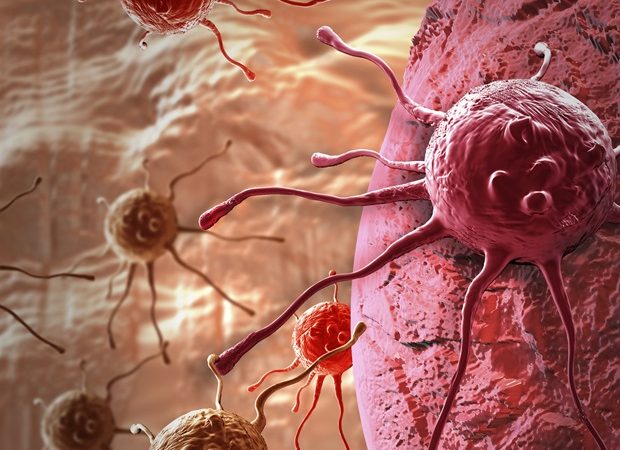 Reviewed
ReviewedNew drug combo shows promise in targeting RAS-mutant multiple myeloma

 Reviewed
ReviewedThe combination of a drug and a protein fragment prevents the growth of blood cancer cells, a new study in mice shows.
The work addressed multiple myeloma, a cancer that forms in blood cells that normally fight infections by making proteins that remove germs. The cancerous cells build up in bone marrow, crowding out healthy blood cells and making faulty proteins. There might be no symptoms at first, but many patients later experience bone pain, nausea, brain fog, fatigue, or infections.
In about half of multiple myeloma cases, changes in the DNA of the RAS gene—which encodes a switch that regulates growth—cause the related RAS protein to become "stuck in the on mode" and cause cancer, researchers say. Currently, there are no effective treatments for multiple myeloma when patients relapse, a setting where genetic changes (mutations) in RAS become more common. This includes attempts to directly counter abnormal RAS function, and this has moved the field to explore other ways of targeting RAS tumors.
Along these lines, RAS mutations also turn up a cellular pathway called macropinocytosis, which normally engulfs nutrients like proteins and fats outside of cells and pulls them inside, where they can be used as extra metabolic fuel. Cancer cells cannot multiply without these supplies, and those with RAS mutations become uniquely capable of this type of scavenging, the study authors say.
Led by researchers at NYU Grossman School of Medicine and Tezcat Biosciences, the new study found that a carefully chosen protein called a monobody, linked to a drug called MMAE that prevents cells from multiplying, were together pulled inside the cancer cells to stop abnormal growth in both cell tests and in live animals with the disease.
Our new approach targets cancers that have been very hard to treat. We are taking advantage of a process that is significantly overactive in cancer cells, which focuses the treatment effect on abnormal cells."
Nathan Beals, PhD, study first author, postdoctoral researcher in the Department of Biochemistry and Molecular Pharmacology at NYU Langone
Presented as an oral abstract on December 9 at the 2023 annual meeting of the American Society of Hematology in San Diego, the new work was based in part on monobodies, a class of compounds originally invented by NYU Langone faculty member Shohei Koide, PhD, and colleagues in 1998. The current research team designed a monobody with a simple protein framework that is engulfed by cancer cells with RAS mutations.
Once taken into cancer cells via mutant RAS-induced macropinocytosis, the monobody-MMAE conjugate blocked the action of cell skeleton components (microtubules), keeping the cancer cells from dividing and multiplying.
Studies in isolated, human, RAS-mutant multiple myeloma cells showed that they have continual macropinocytosis underway, where normal cells do not. A cell-tracking technology then showed that the study monobody was taken up through macropinocytosis at a high level into multiple myeloma cells but did not enter cells when the process was not underway. Once inside, the conjugate caused up to a fivefold increase in the death of RAS cancer cells as compared to normal cells.
In studies in live mice with mutant RAS multiple myeloma tumors, treatment with the conjugate at a relatively lower (suboptimal) dose resulted in a roughly sixfold decrease in tumor size after 21 days, while control tumors showed no significant difference in tumor volume. In a subsequent study, a larger dose of the conjugate killed mutant RAS tumors, with no relapses over 60 days, in a "dramatic improvement" over standard care options, the authors said.
In addition, improved outcomes were seen when the conjugate was used in combination with standard anticancer treatments, enabling them to be effective at lower doses and with the potential for fewer side effects.
"Our conjugate improved survival in early tests and has the potential to be important clinically against multiple myeloma," said study senior author Dafna Bar-Sagi, PhD, senior vice president, vice dean for science, and chief scientific officer at NYU Langone.
Along with Dr. Beals and Dr. Bar-Sagi, other NYU Langone study investigators were Faith E. Davies, MD, and Gareth J. Morgan, MD, PhD, in the multiple myeloma research program at NYU Langone's Perlmutter Cancer Center.
NYU holds patents with respect to the study technologies. Dr. Bar-Sagi holds related patents as well, along with intellectual property rights licensed by Tezcat. Dr. Davies is a paid consultant or adviser to Sanofi, Pfizer, Bristol Myers Squibb/Celgene, GlaxoSmithKline, Regeneron, Amgen, Janssen, and Takeda. Dr. Morgan has previously consulted for Sanofi. These relationships are being managed in accordance with the policies and procedures of NYU Langone Health.
Study co-investigators Craig Ramirez, PhD, and Andy Hauser, PhD, former members of Dr. Bar-Sagi's lab, co-founded Tezcat Biosciences, which funded the study.
NYU Langone
Posted in: Medical Research News | Medical Condition News
Tags: Biochemistry, Blood, Blood Cancer, Bone, Bone Marrow, Brain, Brain Fog, Cancer, Cell, DNA, Fatigue, Gene, Genetic, GlaxoSmithKline, Hematology, Macropinocytosis, Medicine, Multiple Myeloma, Myeloma, Nausea, Nutrients, Pain, Pharmacology, Protein, Research, Technology, Tumor